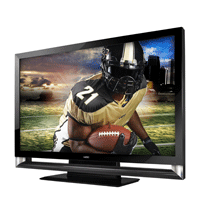
|
|
Photo – 3D TV Photo Courtesy of PRNewsFoto/Discovery Communications Content can encourage sales of HD and 3D televisions installed by electronic home system contractors. For example, 3net, the 3D television network from Discovery Communications, Sony and IMAX, is now carried by DirecTV. |
Avatar is so yesterday. After a push for home 3D-enabled televisions, spurred by the popularity of the movie, those 3D televisions are still a glimmer in the eyes of manufacturers as well as a dusty product on big box store shelves. Still, in the world of high definition, some TV makers, thanks to a Consumer Electronics Association-sponsored study, have recently shifted their programming to emphasize improved energy efficiency of the big screen behemoths.
The question is — how many are tuning into either message?
There’s a definite effort to get the message out.
For example, in February, 3net, a joint venture television network from Sony Corporation, Discovery Communications and IMAX Corporation beat the drum that DirecTV was the first distributor to launch the venture’s 24/7 3D network. The strategy: 3net delivers compelling, native 3D content and serves as a critical driver for consumer adoption of in-home 3D entertainment.
“Quality 3D programming is vital to the success and increased adoption of the technology…3D is here to stay and is only going to get better," says Derek Chang, executive vice president, Content Strategy and Development, DirecTV.

|
|
Photo Courtesy of PRNewsFoto The bigger the screen and the type of underlying technology in the TV make an energy difference that companies are using to pitch LCD TVs. Pictured is a Vizio television. |
Well, maybe or maybe not.
For electronic home system contractors, it’s not necessarily a matter of first comes love, then comes marriage and then comes a 3D TV in a baby carriage.
“I do see some attraction to 3D TV,” says Paul Walczak of Ensemble Custom Solutions, Park Ridge, Ill., and a CEDIA-registered outreach instructor. But he doesn’t pitch 3D. “If a client brings it up, I’ll help. Home 3D is not like the movie experience. The glasses are heavy and battery powered and the resolution can suffer.” He adds, “It still seems like a gimmick. I’ll let the marketplace decide.”
Frederick Ampel, president and principal at Technology Visions Analytics, Overland Park, Kans., takes an even more critical position concerning 3D. “It’s the latest version of the emperor has no clothes.” The home systems consultant contends that most consumers, who have seen 3D in a theater or in a home showroom situation, find it “a gigantic waste of time. Most content in 3D is junk. And most people who have 3D-capable televisions do not use them for that.” It’s a literal headache for some viewers, when he refers to the uncomfortable feelings some 3D viewers experience.
Retailers such as Best Buy, its CEDIA member Magnolia — the high end home systems department — and its on-the-floor “blue shirts,” (yes, they like to be called that) see 3D TV naturally growing in interest. In a tag-team interview with smartHOME, Best Buy/Magnolia’s Tait Jorgensen and Matt Marovich agree that “3D is a big thing.” Marovich believes it is growing similar to the evolution of high resolution TV itself. “It is impacting the premium end but also filtering to the lower end” of the market, he contends. Jorgensen points out that, with the glasses, “there are active shutter models (specific to a certain TV brand) and upcoming passive shutter tech, the universal glasses.” Adds Marovich, “Don’t forget gamers” and their attraction to 3D. He expects Call of Duty and Kill Zone 3 to be reasons why some households will aggressively move to 3D display. In fact, gaming just may prove to be the 3D sweet spot.
Then there are sports such as football, basketball, soccer and NASCAR which can trigger purchasing of 3D TVs, adds Jorgensen.
No doubt, eager techies such as the Best Buy blue shirts see potential sales in 3D TVs. Recent consumer research from Leichtman Research Group of Durham, N.H., found that 61 percent of households in the United States have at least one high definition television (HDTV) set, while about 26 percent have multiple HDTVs. But less than one percent of all households currently have an HDTV set that is 3D-capable. Still, according to Bruce Leichtman, president and principal analyst, “Nearly 80 percent of adults have heard of 3D TV. Of those who have heard of 3D TV, eight percent are very interested in getting a 3D TV.”
Admits Leichtman, "With modest consumer demand for 3D-capable TVs, the potential growth will rely on a continued ‘push’ of 3D TV by manufacturers and retailers, as well as the fact that about one-fifth of all U.S. households purchase a new TV each year." He adds that early adopters of technology are not really out there to pay for 3D TV.
If 3D TV is still emerging, will energy efficient televisions ring up sales for electronic system contractors and retailers? The powers that be, including the Consumer Electronics Association (CEA), are betting their wattage on it.
Released just this month, a study commissioned by CEA shows that manufacturers have made “huge strides” in creating more energy efficient televisions. “Power Consumption Trends in Digital TVs Produced Since 2003” reviewed power consumption data on best-selling digital TV models in both active and standby modes on high-definition liquid crystal (LCD) and plasma display models with screen sizes ranging from 13- to 65-inches. Some highlights:
- LCD active power use fell 63 percent from 2003 to 2010.
- LCD standby power use dropped 87 percent from 2004 to 2010.
- Plasma TV active power use dropped 41 percent from 2008 to 2010.
- Plasma TV standby use fell 85 percent from 2008 to 2010.
“This study proves that it does not take government mandates to produce incredibly efficient TV sets. Intense competition, the voluntary Energy Star labeling program, and physics favoring less heat and thus less power drove these efficiency gains,” says Gary Shapiro, president and chief executive officer of CEA.
Still, government regulation doesn’t hurt. Many manufacturers move to energy efficiency thanks to state laws such as those from California.
To put the gains in context, the power consumption of the average TV sold in 2010 consumes less energy than a 100 watt incandescent light bulb and less power than what is needed to light a typical living room. “Many consumers don’t realize they can replace an old analog TV with a new flat-panel digital TV that uses less energy,” comments Douglas Johnson, vice president of technology policy, CEA. “Power consumption in TVs has fallen dramatically in the relatively short history of digital television thanks to the success of the Energy Star program combined with technological innovation, industry competition and consumer demand.”
Again, energy efficiency as a purchasing factor? Maybe or maybe not.
According to Walczak, “For my high end clients, energy consumption [of televisions] is less a factor” than the quality of the image and size of the display. Ampel agrees. “Energy management today is mostly a one-way street” with most benefits going to the utilities. “I don’t see buyers of televisions making a decision based on energy savings.”
Tech advances are making a difference no matter.
As the CEA study explains, standard fluorescent backlighting for LCD TVs is rapidly being replaced with light-emitting diodes, or LEDs, which will make TVs even more efficient along with enhancing the brightness and contrast of the display. So, in terms of market share, CEA expects LCD TVs to account for 82 percent of TV display sales this year with 27.1 million units shipped. And it expects 4.6 million plasma TVs to ship this year.
The three elements of TV energy consumption are size, type and settings. The bigger the screen, the most power it consumes. Plasma TVs use more power than LCDs, although the gap is closing. LED LCDs use the least power. Brighter images consume more power, and it’s the one element that homeowners can control regardless of the type or size of television.



